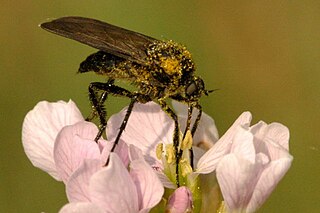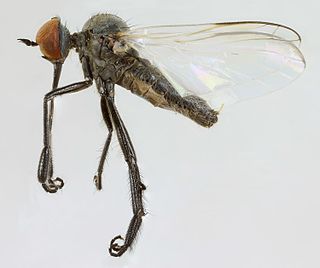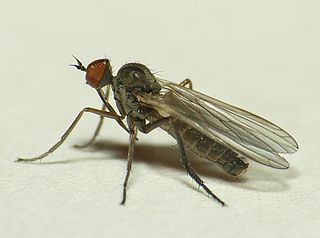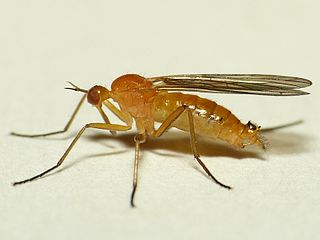
Empididae is a family of flies with over 3,000 described species occurring worldwide in all the biogeographic realms but the majority are found in the Holarctic. They are mainly predatory flies like most of their relatives in the Empidoidea, and exhibit a wide range of forms but are generally small to medium-sized, non-metallic and rather bristly.

Empis is a genus of dance fly found in the fly family Empididae.

Empis tanysphyra is a species of dance flies, in the fly family Empididae. It is included in the subgenus Empis. It is found in most of central and southern Europe.

Empis chioptera is a species of fly in the family Empididae. It is included in the subgenus Empis. It is found in the Palearctic.

Empis nuntia is a species of fly in the family Empididae. It is included in the subgenus Empis. It is found in the Palearctic.

Empis lutea is a species of fly in the family Empididae. It is included in the subgenus Xanthempis. It is found in the Palearctic.
Empis vitripennis is a species of fly in the family Empididae. It is included in the subgenus Coptophlebia of the genus Empis. It is found in the Palearctic.
Empis volucris is a species of fly in the family Empididae. It is included in the subgenus Coptophlebia of the genus Empis. It is found in the Palearctic.
Empis meridionalis is a species of fly in the family Empididae. It is included in the subgenus Leptempis. It is found in the Palearctic.
Empis albicans is a species of fly in the family Empididae. It is included in the subgenus Polyblepharis. It is found in the Palearctic.
Empis tumida is a species of fly in the family Empididae. It is included in the subgenus Pachymeria of the genus Empis. It is found in the Palearctic.
Empis nitida is a species of fly in the family Empididae. It is included in the subgenus Anacrostichus. It is found in the Palearctic.

Empis nigritarsis is a species of fly in the family Empididae. It is included in the subgenus Lissempis of the genus Empis. It is found in the Palearctic.
Empis alpina is a species of fly in the family Empididae. It is included in the subgenus Leptempis. It is found in the Palearctic.
Empis macra is a species of fly in the family Empididae. It is included in the subgenus Leptempis. It is found in the Palearctic.
Empis mesogramma is a species of fly in the family Empididae. It is included in the subgenus Leptempis. It is found in the Palearctic.
Empis strigata is a species of fly in the family Empididae. It is included in the subgenus Polyblepharis. It is found in the Palearctic.
Empis semicinerea is a species of fly in the family Empididae. It is included in the subgenus Xanthempis. It is found in the Palearctic.
Empis univittata is a species of fly in the family Empididae. It is included in the subgenus Xanthempis. It is found in the Palearctic.
Stenoproctus is a genus of flies in the family Hybotidae.





